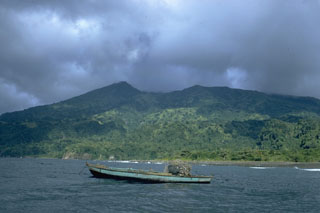Report on Soufriere St. Vincent (Saint Vincent and the Grenadines) — May 1979
Scientific Event Alert Network Bulletin, vol. 4, no. 5 (May 1979)
Managing Editor: David Squires.
Soufriere St. Vincent (Saint Vincent and the Grenadines) Explosions and seismicity end; new lava dome in summit crater
Please cite this report as:
Global Volcanism Program, 1979. Report on Soufriere St. Vincent (Saint Vincent and the Grenadines) (Squires, D., ed.). Scientific Event Alert Network Bulletin, 4:5. Smithsonian Institution. https://doi.org/10.5479/si.GVP.SEAN197905-360150
Soufriere St. Vincent
Saint Vincent and the Grenadines
13.33°N, 61.18°W; summit elev. 1220 m
All times are local (unless otherwise noted)
A new phase of activity from Soufrière began in late April. At 0300 on 29 April, the seismicity that had accompanied the eruption since 12 April ended almost completely, and there have been virtually no local earthquakes since then. Katia Krafft climbed to the crater rim on 3 May and observed a small new lava dome growing in the base of the crater, the same area that had been occupied by the center of the now-destroyed 1971 dome. A sample of the new dome collected by John Tomblin in mid-May was described in hand specimen as a basaltic andesite, similar to the 1971 dome.
By the end of May, the new dome had grown to ~500 m in diameter and 60 m in height. The dome's growth rate was difficult to estimate, but was probably <0.5 x 106 m3/day in late May. Virtually all of the recent expansion of the relatively fluid dome has been lateral rather than vertical.
A few small explosions have taken place from the dome, but none were large enough to project material above the rim (about 300 m above the crater floor). Fumarolic activity from the top of the dome was moderately strong during the early stages of its growth, but had stopped by 20 May. In late May, fuming was still fairly vigorous around the dome, on the floor of the crater. A team from Guadeloupe's volcanological observatory measured a temperature of 239°C from the fumaroles in late May, and collected samples from the dome.
The April explosions deposited a total of about 30 cm of ash on the zone within 1 km of the crater rim. Large numbers of massive dense remnants of the 1971 dome and scoria blocks up to 60 cm in diameter were also found in this zone.
H.H. Lamb's preliminary estimate of Dust Veil Index (Lamb, 1970) for this eruption is from 3 to 9, probably nearer to 3. The Dust Veil Index for the 1902 eruption of Soufrière was calculated at 300; the Krakatau 1883 eruption = 1,000.
Much of the crater floor is presently mantled with rubble. The new dome had spread over the remnants of the old crater lake by about 20 May, but a new lake had begun to form at the beginning of June because of the onset of the rainy season.
Most of the more than 17,000 evacuees were allowed to return to their homes on 14 May, including residents of the two largest towns near the volcano, Georgetown and Chateaubelair. Restrictions remain in effect for the 4,000 persons who live in the zone devastated by the 1902 eruption, N of the Rabacca and Wallibou Rivers.
Reference. Lamb, H.H., 1970, Volcanic dust in the atmosphere: Philosophical Transactions of the Royal Society of London, series A, v. 266, no. 1178, p. 425-533.
Geological Summary. Soufrière St. Vincent is the northernmost and youngest volcano on St. Vincent Island. The NE rim of the 1.6-km wide summit crater is cut by a crater formed in 1812. The crater itself lies on the SW margin of a larger 2.2-km-wide caldera, which is breached widely to the SW as a result of slope failure. Frequent explosive eruptions after about 4,300 years ago produced pyroclastic deposits of the Yellow Tephra Formation, which cover much of the island. The first historical eruption took place in 1718; it and the 1812 eruption produced major explosions. Much of the northern end of the island was devastated by a major eruption in 1902 that coincided with the catastrophic Mont Pelée eruption on Martinique. A lava dome was emplaced in the summit crater in 1971 during a strictly effusive eruption, forming an island within a lake that filled the crater. A series of explosive eruptions in 1979 destroyed the 1971 dome and ejected the lake; a new dome was then built.
Information Contacts: W. Aspinall, K. Rowley, J. Shepherd, and J. Tomblin, UWI; K. Krafft, Cernay, France; H. Lamb, Univ. of East Anglia.

